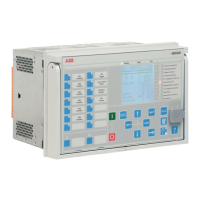3.14.4 RESTVTR function block
3.14.4.1 Function block
Figure 55: Function block
3.14.4.2 Functionality
The RESTVTR function is used in the receiver application to perform the supervision
for the sampled values of analog residual voltage and to connect the received
analog residual voltage input to the application. Synchronization accuracy, sampled
value frame transfer delays and missing frames are being supervised.
The typical additional operate time increase is +2 ms for all the receiver
application functions (using either local or remote samples) when SMV is
used.
3.14.4.3 Operation principle
The ALARM in the receiver is activated if the synchronization accuracy of the sender
or the receiver is either unknown or worse than 8 ms. The output is held on for 10
seconds after the synchronization accuracy returns within limits.
ALARM is activated when two or more consecutive SMV frames are lost or late. A
single loss of frame is corrected with a zero-order hold scheme. In this case, the
effect on protection is considered negligible and the WARNING or ALARM outputs are
not activated. The output is held on for 10 seconds after the conditions return to
normal.
The
SMV Max Delay
parameter defines how long the receiver waits for the SMV
frames before activating the ALARM output. This parameter can be accessed via
Configuration/System/Common. Waiting of the SMV frames also delays the local
measurements of the receiver to keep them correctly time aligned. The
SMV Max
Delay
values include sampling, processing and network delay.
The WARNING output in the receiver is activated if the synchronization accuracy of
the sender or the receiver is worse than 4 μs. The output is held on for 10 seconds
after the synchronization accuracy returns within limits.
The WARNING output is always internally active whenever the ALARM output is active.
Basic functions
1MRS757644 H
138 620 series
Technical Manual

